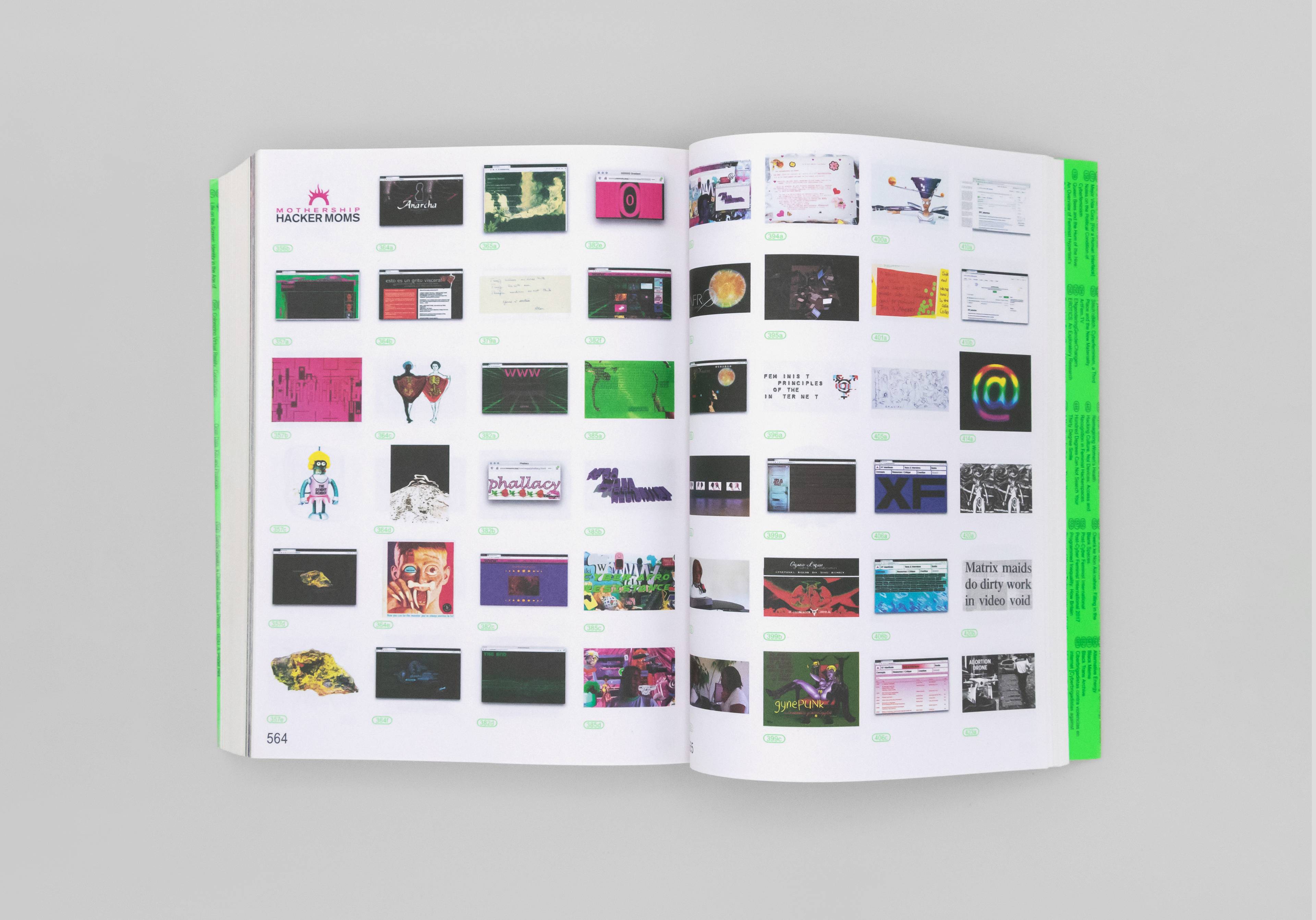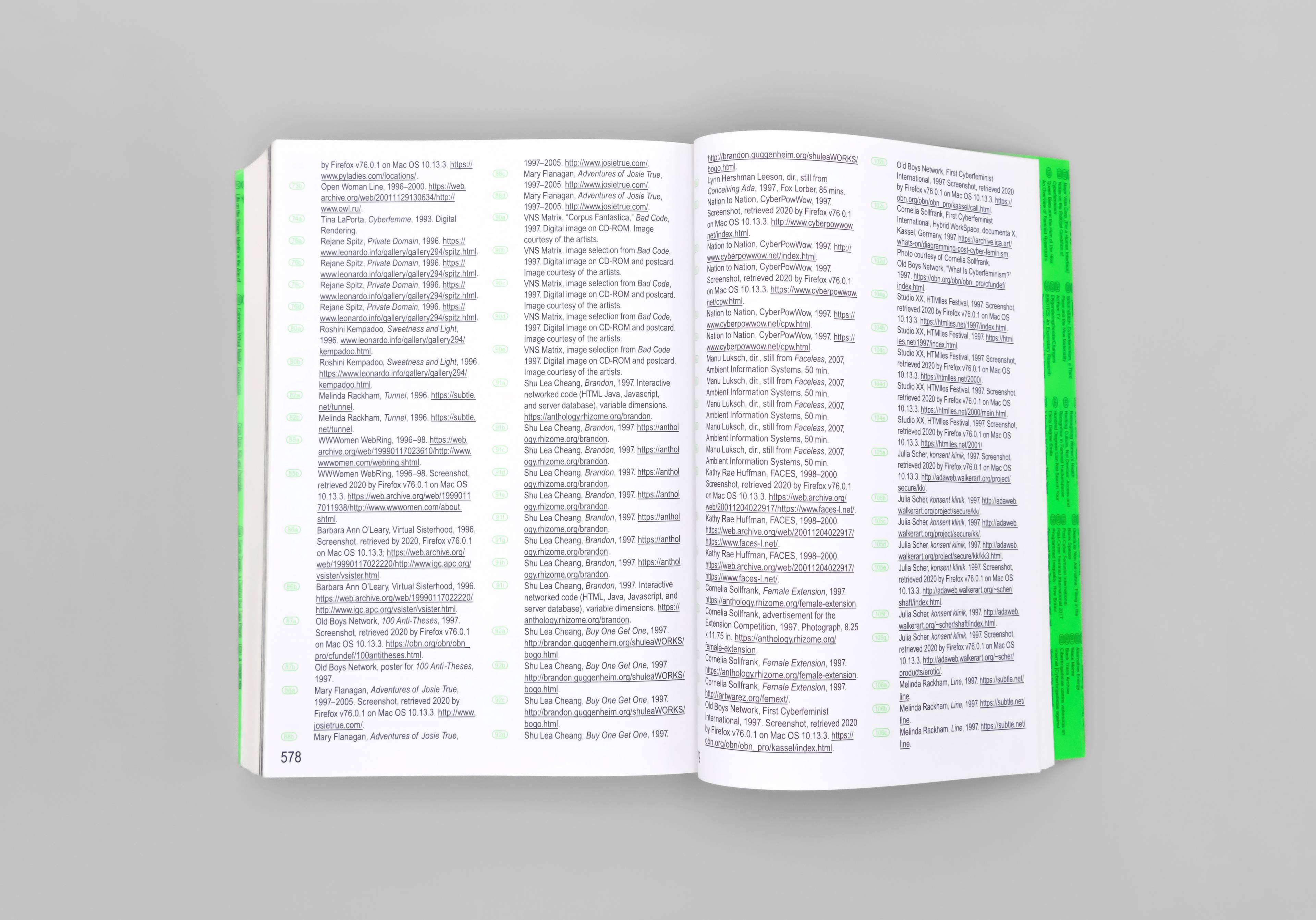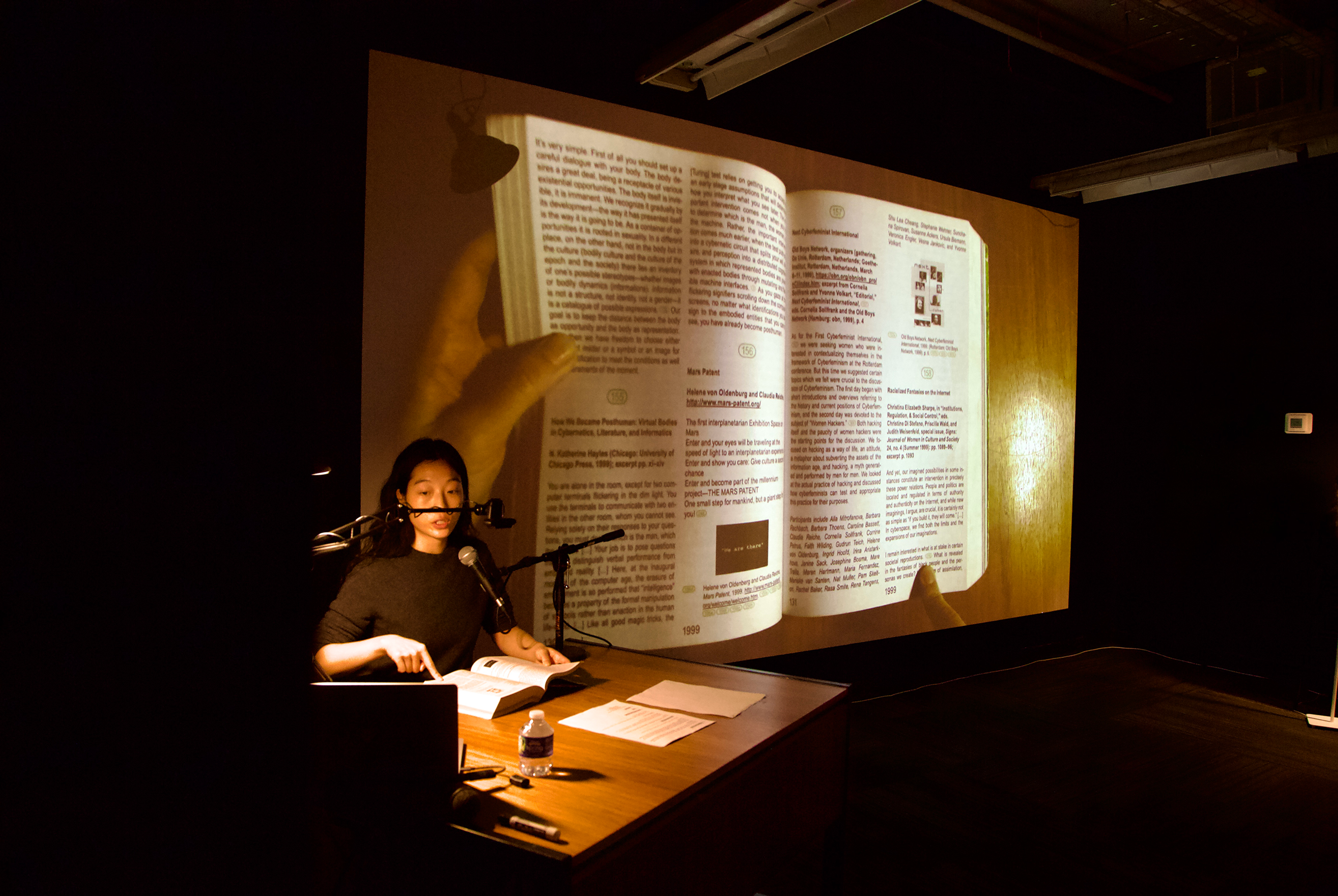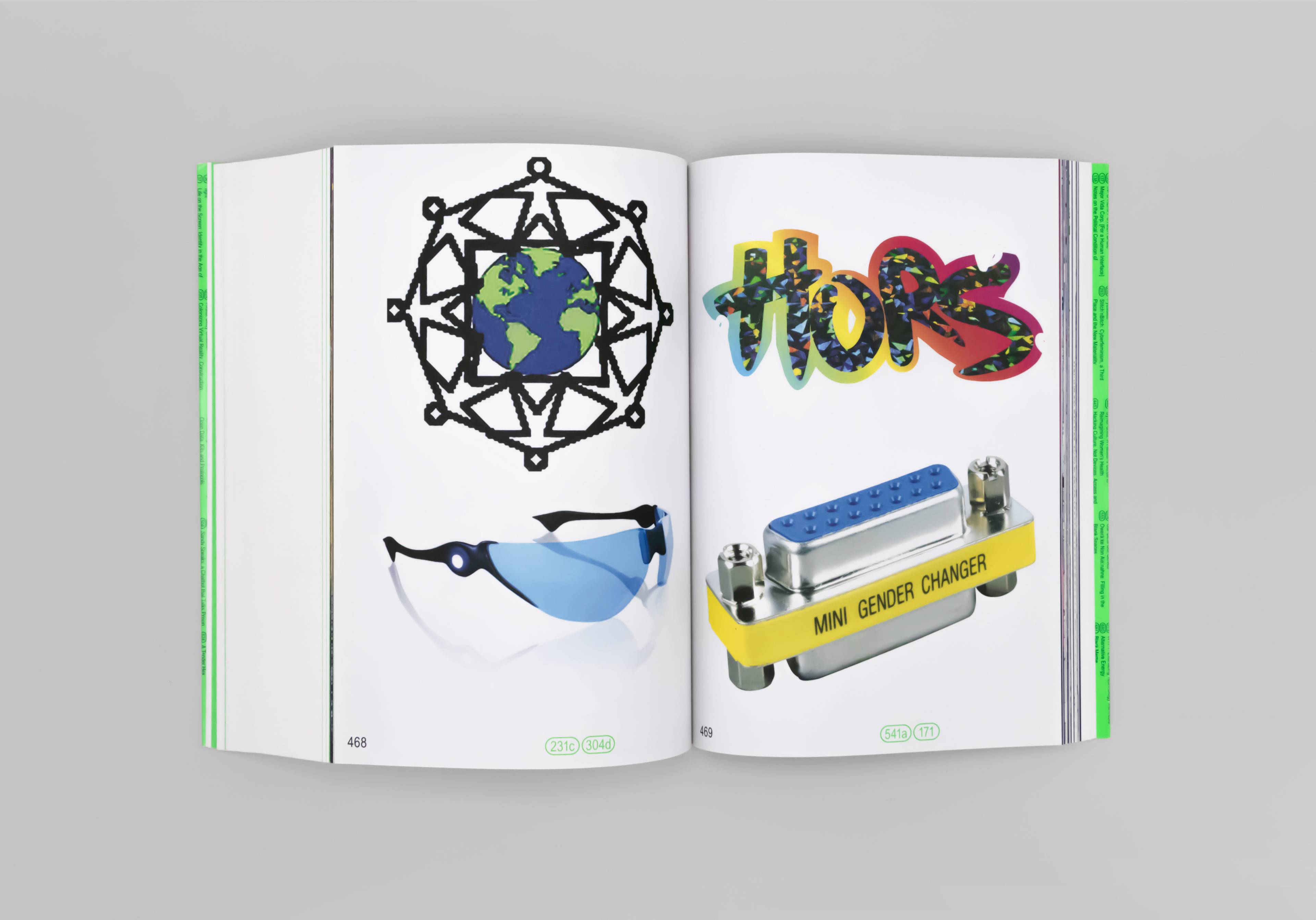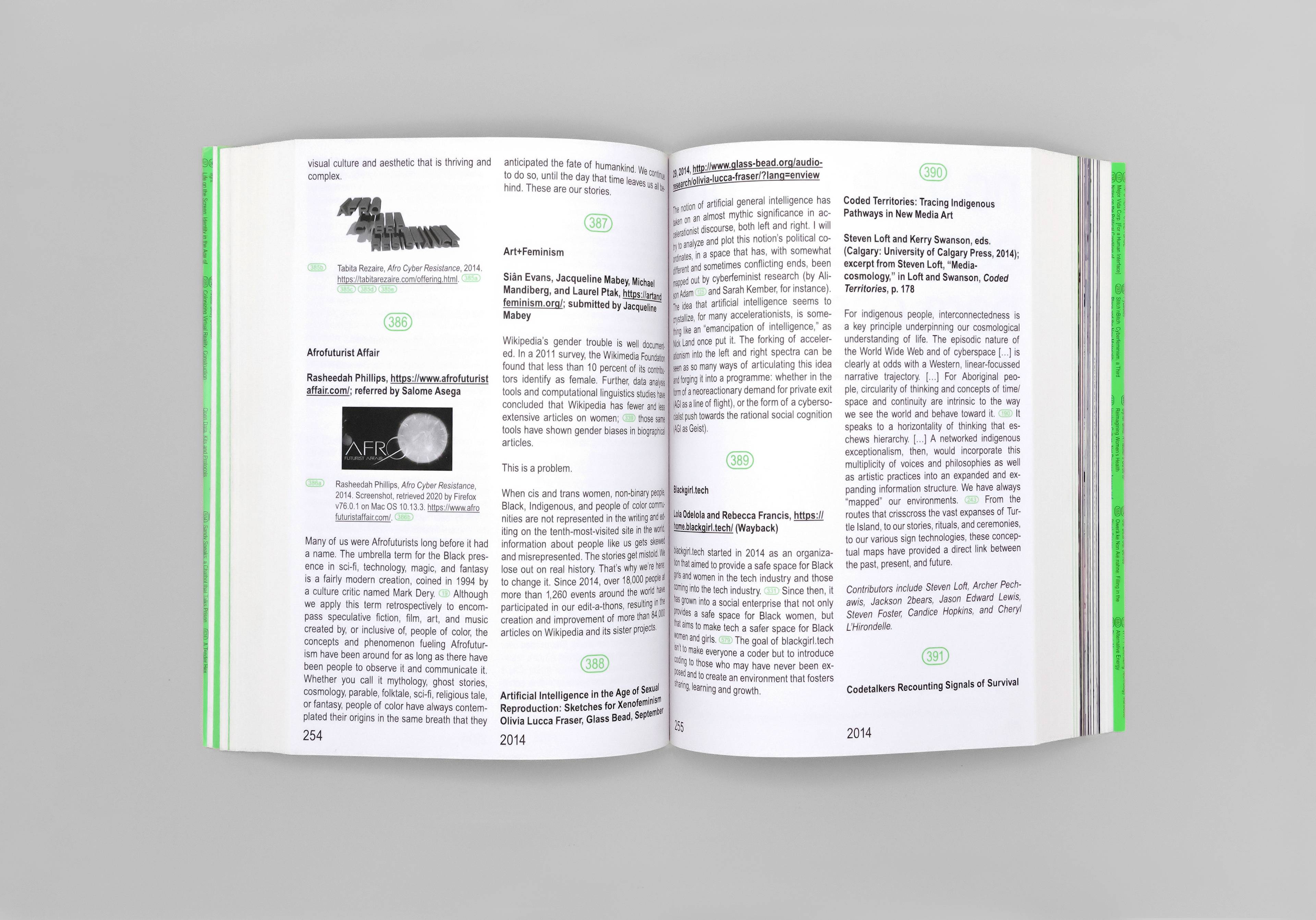The cyberfeminism of the early 1990s is making a comeback, as a younger generation of artists and technologists reimagine its politics and aesthetics for our “post-gender,” “post-internet” world. For example, in the spring of 2019, the Migros Museum für Gegenwartskunst in Zurich presented “Producing Futures—An Exhibition on Post-Cyber-Feminisms,” a group survey of “different feminist approaches that turn the spotlight on the tension between the body and technology and on discriminatory gender norms,” ranging from Lynn Hershman Leeson’s Digital Venus” drawings (1996–2001) to Mary Maggic’s Estrofem! Lab kits (2016–17).
On 6 March of that same year, Mindy Seu, a multi-hyphenate designer, educator, and researcher whose practice focuses on revising internet history, tweeted: “I’m creating a cyberfeminist index. I’m looking for non-Western and intersectional references, esp. from the 90s and 00s.” Her post linked to a submission form that ultimately crowd-sourced almost 700 entries, which together tell a global, horizontal story of the first three decades of cyberfeminism, from black cyberfeminism to hackfeministas and 넷페미 (netfemi).
With the support of the net-art non-profit Rhizome, and in collaboration with the computational designer Angeline Meitzler and the graphic designer Laura Coombs, Seu transformed the spreadsheet, first into the searchable website cyberfeminismindex.com, then into a physical book, the Cyberfeminism Index (2022). The hefty tome of cross-references, which readers can navigate via one of the thematic paths outlined by sixteen notable cyberfeminists, or by using the entries like hyperlinks, has become an indispensable resource for historicizing the putting into practice of contemporary technology criticism.
The interview below is an edited version of a conversation that took place at Squeaky Wheel Film & Media Art Center in Buffalo, New York, on 2 November 2023.
Spreads from Mindy Seu, Cyberfeminism Index, 2022. Courtesy: the author and Inventory Press
Tina Rivers Ryan:The Cyberfeminism Index started out as a Google Sheet, became a website, and now is a physical object, straddling the ever-shifting boundary between the analog and the digital.Perhaps we can start by talking about the lecture-performance you’ve been giving on your book tour, during which you project the Cyberfeminism Index on screen and activate it using augmented reality (AR).
Mindy Seu: When talking with Laura Coombs, the book’s designer, we knew we wanted the book to be a performative object.It’s not like the books that you typically see: Maybe it’s an encyclopedia, maybe it’s a compendium, but because of its unusual form, we knew that it had to be demonstrated. So, I asked Tommy Martinez, the former Director of Technology at Pioneer Works, to create an AR application that would make the book into an interface. The performative reading is a way of simultaneously talking about and demonstrating new media. It was also a way of exploring the breaking points of tools: spreadsheets used as an index, rather than for data management; Unity (a gaming software) used to make a book into a digital interface, even if it’s meant for gaming. Pushing these boundaries highlights how we can make tools work for us rather than playing out the behaviors that they’ve trained us into.
TRR: Can you say more about the kinds of design and editorial choices that you made in the production of the book itself? And, more specifically, what political choices were embedded in your design choices?
MS: We wanted to make this book as economically as possible, so we chose a cheap, recycled paper that has a nice heft to it. It looks like a big book, but when you touch it, it’s very fluffy. We wanted it to feel like a usable, non-precious object – it’s supposed to be a source book, not a coffee table book. We used an Arial font, because it’s one of the few system fonts co-designed by a woman (Patricia Saunders, for IBM in the early 1980s). The cover folds out on both sides to show the full index, the width of which is determined by the length of a broadsheet, so we could fit as many covers on one broadsheet as possible.
Mindy Seu’s lecture-performance at the Squeaky Wheel, Buffalo, New York, 2023. Courtesy: the Squeaky Wheel. Photos: Ekrem Serdar
Mindy Seu and Tina Rivers Ryan
TRR: Something else that struck me is that each entry is sorted first by year, then alphabetically, which is very different from your typical art-history survey text, in which certain figures are implicitly or explicitly privileged over others. You use the word rhizomatic to describe the project, but it’s also more horizontal. Could you speak to the organization of the content?
MS: We tried to create a horizontal space in which people could select what actually resonates with them. Whatever stands out to you is going to be wildly different from what stands out to me, and you can then connect those entries to other things, building associative links. We also invited different activists, scholars, artists, and collectives to create a collection housed at the start of the book. It’s not suggesting that Skawennati’s “Indigenous Futurism” collection shows every single Indigenous work in this codex; rather these are the ones Skawennati linked together – it shows their trails.
TRR: I wanted to switch gears to talking about the intervention that the project makes into the historiographies of technology and of feminism, and how it conjoins those discourses. You write in your introduction, “The works collected here are valuable and necessary additions to technology studies broadly. They cannot and should not be siloed into scholarship on gender.” Why does everybody need cyberfeminism? And where does this book sit on our bookshelves?
MS: I want the Cyberfeminism Index to sit alongside other books on art and technology and not in gender studies. Feminism responds definitionally to how the system of patriarchy affects everyone, which isn’t specific to gender. Fields like feminist economics are not about women in economics; rather, they analyze the actors that drive economic-social, paid-unpaid, public-private binaries and the like, which is also what we’re trying to draw out in this book. There’s definitely an arts focus, but it’s also a holistic overview of the application layer of the stack, its social usage: a lot of activism, a lot of pedagogy, a lot of net art and art beyond the screen. We push against the narratives that grandfathers alone created the protocols and architecture of the internet. We understand that women were part of creating the hardware, while also pushing forward its applications.
For grassroots or independent projects like the Cyberfeminism Index, you can infiltrate these “forever institutions” to raid their resources.
TRR: I would love for you to talk about the cyberfeminist politics inherent to your assembly of this project. You’re not just the “editor” of this book; you’re also credited as the “gatherer,” which you explain as related to Ursula K. Le Guin’s essay “Carrier Bag Theory of Fiction” (1986).
MS: We actually borrowed the term from adrienne maree brown’s byline in Pleasure Activism (2019). Laura first noticed that it said “written and gathered by …” In Le Guin’s text, she posits that the first tool was not the spear, a tool of domination, but actually the basket, a tool of communion. This shifts and expands our idea of technology away from the digital and towards analog and ancestral technologies. But it also recenters our idea of the protagonist away from the individual hero and towards a collective, away from a “he” and towards a “we.” In this book, we felt responsible for bringing together these disparate entries for a specific community, with various containers for sharing.
TRR: Speaking of shifting from “he” to “we”: The Index started out as your own independent project, then became crowdsourced, before you became involved with Rhizome, a net-art organization that has been around since the 90s and is now affiliated with the New Museum. So, it went from being a grassroots project to an institutional one. This leads me to wonder: What do you think is the role of institutions in cyberfeminism more broadly? (I ask this as a curator who, while working for an institution, is interested in artists who actively trouble institutions or resist institutionalization!)
MS: Activism can happen outside the institution, on the street. But this can also happen within institutions, as their workers reflect on what their constituents are trying to do, often at the cost of creating and dispersing a productive tension with someone higher up at the institution.
For grassroots or independent projects like the Cyberfeminism Index, you can infiltrate these “forever institutions” to raid their resources. By working with a legitimate press, we have a proper ISBN, so it’s now housed in the Library of Congress. If the website goes down, if all the other copies burned, there will be a record for future-proofing this snapshot of this particular collection of works.
Spreads from Mindy Seu, Cyberfeminism Index, 2022. Courtesy: the author and Inventory Press
TRR: I like the idea of raiding resources – that sounds very cyberfeminist. It also begs the question of who gets to have those resources in the first place. This leads me to a final question, which is also a personal one for me: You’ve spoken about the fraught politics of being a young woman in academia and what it's like to be in these spaces as a body that is gendered as female. In preparing for our talk, I read all of the interviews you’ve given about the Index, and I noticed that sometimes you get questions about your beauty routine, your workout routine, or your diet. And as we know, social-media algorithms are written to privilege certain kinds of content – such as selfies – over others. So how do we navigate that while identifying as cyberfeminists?
MS: Either way, it feels like a performance. When you have these interviews that focus solely on the work, you’re performing an intellectualized identity. And when interviewers ask about very personal things, it’s like they’re trying to humanize or make more accessible this intellectualized person. I don’t mind those sorts of questions – we can talk in depth about media theory, then pivot just as quickly to reality TV. I also think that if someone reads an interview that asks about skincare, and that leads them to our book and makes them question how they use Instagram, that’s kind of a win: There are all sorts of different entry points into this space. Again, it’s a matter of the intended function or behavior, versus ways we can subvert that towards some other call to action. And if those invitations come from glitches or breaking points, that’s even better.
___





